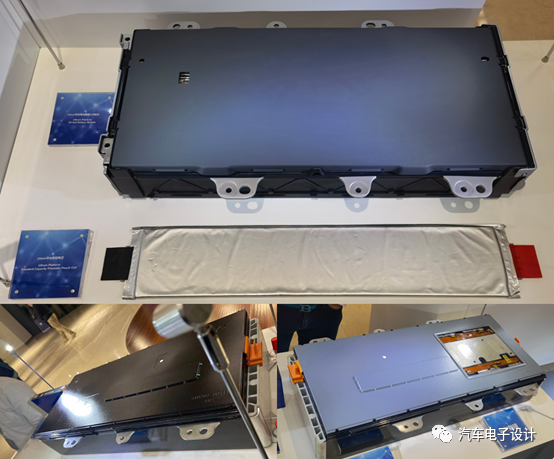Introduction
During SAIC-GM’s Tech Day, there were various showcases, including Pack and Module Design. Today, we will focus on the battery module design, specifically about Ultium’s module design.
There are a few key features of Ultium’s module design:
- The module consists of one soft-pack cell and two differently thick prismatic cells. The module is compatible overall in size.
- Each module utilizes integrated cooling technology, where the water-cooled plate is integrated at the bottom.
- For the prismatic module, both ends have leads, while for the soft-pack module, only one end has leads. As such, the Pack is compatible with both types of high-voltage busbars. Simplifying the overall design by removing the low-voltage sampling and communication wires.

Prismatic Module
SAIC-GM showcased Ultium’s prismatic cells, which can be grouped into two types depending on thickness, while the height and width remain the same. The design of different cells’ vents was innovative.

When it comes to technical advances, SAIC-GM has decided to adopt the ternary path in China. As energy density in cells increases, there are several key areas for thermal runaway protection:
- Insulation material is used as protection between each cell.
- Mica sheets are used above the cell vents to provide thermal resistance, so the module’s top cover remains plastic.
- Integrated cooling to achieve improved heat dissipation in both normal and thermal runaway conditions.

There is no visible low-voltage interface design in this module design. The protruding part may be a Wireless CMU’s PCBA, which is powered and sampled via FPC.

Soft-Pack ModuleThe design of the battery pack only shows one module and no disassembly is performed due to the fact that the design of this module is not the focus of the design release in China. The module is the same size as and shares the mounting points with the “方壳” module, and has been processed with a common output interface in the same direction at the bus output interface of the battery pack. Because there is space in the Z direction of the module, the protruding structure of the wireless CMU is not visible. Regarding the display of battery cells and design animations, the concept is similar to the MEB battery pack and “方壳” module in terms of compatibility design with Volkswagen. The battery pack module itself has a universal design with two different stacking directions and different heights and capacities. The design on the far left may be the result of this design.

Summary:
Before the auto show, SAIC General Motors demonstrated Ultium technology on site for the first time. This is a preview of the import of this design by General Motors in China, which is expected to provide guidance for the sales of General Motors’ electric vehicles in China.
This article is a translation by ChatGPT of a Chinese report from 42HOW. If you have any questions about it, please email bd@42how.com.